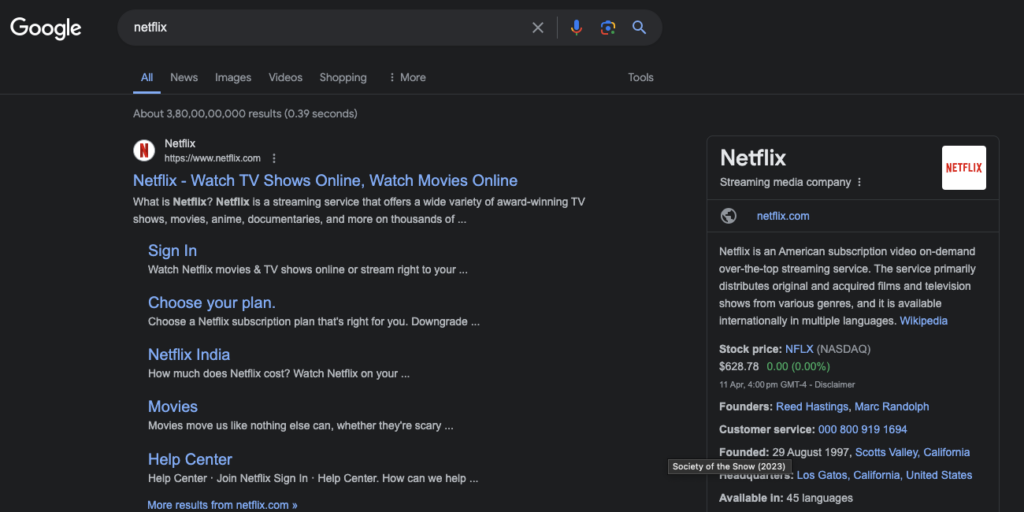According to Statista, people spend six hours and 40 minutes online daily. In this digital age, it’s become essential for brands and individuals to have a strong online presence. You must be visible in spaces where your target audience spends their time.
This requires learning and implementing robust strategies to boost your presence and reputation in the digital space. In this article, let’s examine what you need to do to give yourself a competitive edge.

Table of Contents
What Is Online Presence Management? Starting With the Basics
Online presence management is the practice of using various strategies to monitor and maintain your footprint in the digital space. In other words, it is a process of making it easier for everyone to find you on the internet.
Here’s a simple example to show you why this is important. Let’s imagine you are running a restaurant. You spent countless years training under several master chefs to hone your culinary skills. You only use high-quality, organic, locally grown ingredients for your dishes. The design and decor complement each other, adding to the dining experience.
However, you don’t have a website for your restaurant highlighting your expertise and how you source various ingredients. Your establishment is absent on every social media platform. Also, you don’t have a Google Business Profile, formerly Google My Business. As a result, your restaurant doesn’t show up on popular mapping software like Google Maps.
Now, people learn about your establishment from their friends. If they search for your restaurant online, they don’t find anything substantial. There are no reviews about your eatery anywhere.
People don’t know the location of your establishment as there is no listing on Google Maps. Also, there are no pictures showcasing your restaurant’s tasteful decor. As a result, barely any people turn up to your eatery.
You can turn things around by establishing and managing your presence in the online world.
People, even those who don’t know about your existence, can learn about your brand. It helps add legitimacy and credibility to your brand, increasing trust among potential customers.

How To Build an Online Presence: Get Started With These 5 Tested Strategies
Now that you’re aware of the importance of being visible in the digital space, you should know how to build an online presence. Below are five tested strategies to help you start this process.
1. Create a Website to Plant Your Brand’s Flag in the Virtual World
Take the first step to establishing your digital presence by creating a website for your brand. For starters, the domain, i.e., the link to your website, should be your or your company’s name.
You can have dedicated pages to showcase your brand and its products or services. Thanks to website builders like Shopify, Webflow, Wix, and Squarespace, it’s easy to build and maintain a site. Also, these services cater to every budget.
When building a website, you need to put yourself in your customers’ shoes. Make the design appealing by using the right colors, stunning visuals, and readable fonts. Also, it should be easy to navigate on a smartphone, as this is what most people use to visit websites.
Ensure all the buttons work and the pages load quickly. Remember, visitors don’t like to wait and don’t want to encounter broken elements on your website. Also, people tend to judge your brand depending on how your site looks and performs.
2. List Your Brand in Various Online Directories
The next step is to ensure your brand is visible on various online directories. They increase your online visibility while also providing essential information.
For example, with Google Business Profile, people can get your business’s working hours, location, services, and contact information. Your customers can leave reviews, which will be visible to other consumers. Also, people will be able to see your business on Google Maps.
Yelp is another excellent online directory. People go to this site to learn more about businesses before visiting or purchasing products from them. Apple Maps also uses this directory to display customer reviews and ratings.
Trustpilot also allows your customers to review your business after they visit your establishment or purchase your offerings.
Don’t forget to include a listing of your brand in Bing Places for Business. As per Statista’s database, 1.3 billion unique visitors go to Bing every month.
3. Learn and Implement Various Search Engine Optimization (SEO) Strategies
Search engine optimization (SEO) is crucial in establishing and maintaining your presence on various search engines. It is the practice of increasing your website’s visibility on various search engines.
When you look for something online, you are most likely to open links on the first page of search results. Think about it — when was the last time you went beyond the first search results page on Google? Also, will you trust what you see on Google Search’s third or fourth page?
Appearing on the first page improves your brand’s visibility and adds to your credibility.
When starting out, you don’t have to spend money on SEO tools. Google Search Console, Google Analytics, Google Lighthouse, Google Keyword Planner, and Google Page Speed Insights are all free. These tools help you analyze your website and give you insights on what you should improve.
Once you get the hang of free software, you can see whether it is worth getting the paid tools.
Initially, it can seem overwhelming to jump into this space. Luckily, loads of text and video-based guides online provide detailed step-by-step instructions.
4. Join the Right Social Media Platforms To Improve Your Brand’s Visibility
According to Statista, more than 4.59 billion people worldwide use social media. These platforms are some of the best places to build your online visibility. You get to interact with your target audience directly, build relationships with them, and convert them into loyal customers.
Potential customers use social media platforms to learn and form opinions about various brands.
Social media networks give you the opportunity to humanize your business by giving it a face and a voice. These platforms can also be part of your sales funnel and drive visitors towards your website.
However, this doesn’t mean you join all the social media channels possible. For starters, you should find out which social platforms are popular among your target audience. You can get this information by studying your competitors.
You must be active on these platforms to maintain your social media presence. This is challenging if you join too many social networks but don’t have the bandwidth to post on them regularly.
5. Boost Your Brand’s Visibility Substantially With Online Advertising
Online advertising is the final piece to your brand’s visibility in the digital space. It allows your business and its products or services to be visible in the right place at the right time. Online advertising is affordable, unlike conventional marketing channels.
For example, when you run Twitter or X ads, the platform only charges you for specific actions.
Also, with digital advertisements, you can fine-tune who can see your ads and where they appear. Depending on your marketing strategies, you can target people from a specific region, income range, gender, interests, and more.

What Is Online Reputation Management?
Online reputation management involves using various techniques to proactively prevent and address any issues regarding your brand’s image and credibility. It is a part of managing your online presence.
When your brand becomes visible to your audience, it’s inevitable that people will leave bad reviews. What you do in these situations significantly impacts people’s perceptions of your business. Bad reviews can quickly become a nightmare and damage your credibility. They will also affect your sales, as people will assume your brand is untrustworthy.
By monitoring your online reputation regularly, you can quickly address the problems your customers face. It gives you valuable feedback, which helps improve your products or services.

3 Tips To Manage Your Online Reputation
Managing your digital reputation is essential to your brand’s survival in the digital space. Potential customers will start looking elsewhere if there are too many negative reviews. Below are three tips to help you manage your reputation.
1. Always Monitor What People Are Saying About Your Brand
Knowing people’s perceptions of your brand is essential to ensure their opinions don’t blindside you. For starters, after you set up your business profile on Google, you should check your account for reviews regularly.
Similarly, you can follow conversations on various social media platforms via social listening. Several social listening tools, such as Brandwatch, Hootsuite, and Brand24, can help you with this task. Essentially, they let you know what people really think about your brand.
If you’re on X, formerly Twitter, the platform’s advanced search lets you quickly find specific posts.
2. Have a Comprehensive Strategy To Manage Your Online Reputation
How your brand responds to negative reviews significantly influences people’s perception of your company. Having guidelines ensures you and your team can quickly and consistently respond to such situations.
For example, you can dictate how your brand should communicate with consumers. There should be a tone you should use to ensure your responses don’t further damage your reputation.
Also, there must be policies in place to make it easier for your brand to take action. First of all, whose responsibility is it to respond to customer reviews? At what point should you start offering discounts to unhappy customers?
Having response templates is handy as you can communicate with people quickly.
3. Acknowledge Your Mistakes and Quickly Respond To Negative Reviews
Being defensive when customers point out product and service issues will damage your reputation. When it is evident that the fault lies with your brand, acknowledge your mistake. It takes a lot of courage, and your customers appreciate it when you do this.
Whenever a person leaves a negative review, you must respond immediately. This shows you’re paying attention, and customers can easily approach your business. If you take too long to get back to consumers, it becomes harder to repair your reputation.

TweetDelete To Manage Your Online Reputation and Presence on Twitter Easily
Managing your digital presence makes it easier for people to find and learn more about your brand. This increases awareness of your business and can help consumers make the right purchase decisions.
What you post on X, formerly Twitter, significantly impacts your online reputation. If you publish the wrong content and like controversial, insensitive, or offensive tweets, your reputation will take a hit.
This is usually the case with your older posts, as you were a different person back in the day. Even if you change and improve, your older tweets will resurface to say otherwise. As time passes, you must scan your Twitter profile and delete unwanted posts.
Thanks to TweetDelete’s custom filter, you can do this quickly. After you locate all the reputation-damaging posts, you can remove them quickly with the bulk-delete tweets feature.
You can also automate this activity with the auto-delete task. TweetDelete will ask you the Twitter keywords in the reputation-damaging tweets. You’ll also need to provide a date range to only target these posts.
What you like on X also impacts your online presence and reputation. People can easily see this activity if they visit your profile page. TweetDelete will erase likes from specific posts to ensure your online behavior doesn’t affect your credibility.
Use TweetDelete today to maintain a clean and customer-friendly image on Twitter!










